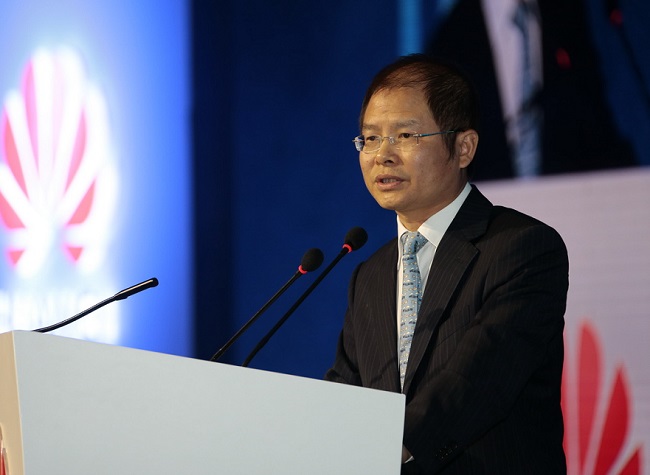Sound the alarm: Huawei is out to disrupt the enterprise IT giants
By Goh Thean Eu June 3, 2016
- Enterprise business grew by over 44% in 2015
- Currently its third largest revenue contributor

AFTER spending the past two decades disrupting the telecommunications industry – basically the European vendors – telco gearmaker Huawei Technologies Co Ltd is now aiming to make its presence felt in the enterprise IT space.
It is armed with a suite of cloud services, storage solutions, switches and routers, surveillance cameras, as well as big data and the Internet of Things solutions – aimed at the markets now plied by the big boys like Amazon, Cisco, EMC, IBM and others.
“For the past 10 years, it was ‘All IT’ – today, it is ‘All Cloud’,” Huawei rotating chief executive officer Eric Xu (pic above) said during a question-and-answer session with analysts and media at its 13th Global Analyst Summit in Shenzhen recently.
At the summit, Xu shared the company’s full ‘cloudification’ strategy. For a start, Huawei will “walk-the-talk” and embrace cloud technologies in a big way internally, he said.
“In the next few years, Huawei will fully ‘cloudify’ all its operations and services,” said Xu, adding that this strategy will be built on five pillars: Real-time, on-demand, all-online, do-it-yourself and social, or ROADS for short.
“In the All-IP (Internet Protocol) era, we proposed our single strategy, which effectively supported the development of operator customers.
“Today, as we face the digital transformation of different industries, we advocate full cloudification to build efficient networks and agile competitiveness.
“A ROADS experience cannot be achieved without support from services, networks, and operating systems,” he added.
Booming enterprise segment
Huawei’s enterprise business was one of its fastest growing segments in 2015, registering a 44% growth in revenue to 27.61 billion yuan (US$4.2 billion). It was the third largest revenue contributor after its carrier and consumer divisions.
While its enterprise revenue growth outpaced most of its rivals in the space, the absolute amount is still relatively small compared with the enterprise IT giants’.
For example, networking giant Cisco Systems Inc’s revenue for the full year ended July 25, 2015 was almost US$50 billion, and storage giant EMC Corp’s annual revenue is well above US$20 billion.
To close the gap on, let alone overtake, these enterprise IT giants may seem like a tall order for now, at least from a revenue perspective, but it is by no means impossible.
After all, Huawei managed to disrupt the European telecom vendors which were in similar market-leading positions.
In the late 1990s and early to mid-2000s, most telecommunications services providers picked European telecommunications equipment makers as their choice of vendors. However, things started to change when China-based telecoms equipment makers started knocking on their doors.
Over the next few years, the Chinese companies gave European vendors a run for their money as they were able to offer equipment at nearly the same specifications, but at significantly lower prices.
This essentially transformed the industry.
Vertical-by-vertical march

Huawei’s enterprise business has been gaining positive traction globally. According to the company, its Safe City Solution – consisting of surveillance and facial recognition solutions, among other technologies – has been implemented in more than 100 cities in over 30 countries.
Its omnichannel banking solution has also been commercially deployed in more than 300 financial institutions, including six of the world’s top 10 banks.
In the energy sector, its Advanced Metering Infrastructure solution has helped IE, a power company in Nigeria, build a smart power consumption system.
In the education sector, Huawei’s smart campus solution has been implemented in over 200 universities around the world, and its smart classroom solution is being used in countries like the United States, Turkey, South Africa and, of course, China.
Meanwhile, its data centre solutions are being used by France’s Criteo and India’s Flipkart, as well as data centre service providers like Evry in Norway, Digital Sense in Australia, and iAdvantage in Hong Kong.
“Digital transformation is now taking place across all industries,” said Huawei executive director and strategy marketing officer William Xu.
“We believe that the digital transformation market will expand to US$1.5 trillion by 2025, and we will help industries achieve this digital transformation through the ‘All Cloud’ strategy,” he added.
IoT game-plan
In line with digital transformation, there is also the IoT boom. Huawei has in its arsenal here products such as the Smart Home Gateway for residential users and the Agile Access Router for industrial users.
It also plans to launch a new narrowband (NB) cellular network for the IoT, according to Huawei marketing and solutions department president Patrick Zhang.
“This is basically for ‘massive things.’ It has the capability to establish 100,000 connections per cell, and it is 100 times more efficient compared with 4G (Fourth Generation mobile technology),” he said.
“The NB-IoT network will have better indoor coverage, and has the ability to penetrate one more wall than 2G technology,” he added.
Beyond the equipment end, the company has also developed an operating system for its IoT devices, dubbed LiteOS, announced last May.
The LiteOS has a kernel ROM (read-only memory) of under 10KB and has a response time of only 1ms (millisecond) latency.
Last year, Huawei’s IoT business recorded revenue of US$1.3 billion. “This is just the beginning – the main course is coming,” Zhang declared.
Goh Thean Eu reports from Huawei’s Global Analysts Summit 2016 in Shenzen at the invitation of the company. All editorials are independent.
Related Stories:
Huawei launches its first ‘container data centre’
Huawei’s first global training center outside China
Huawei reports 30% rise in revenue for H1 2015
For more technology news and the latest updates, follow us on Twitter, LinkedIn or Like us on Facebook.


